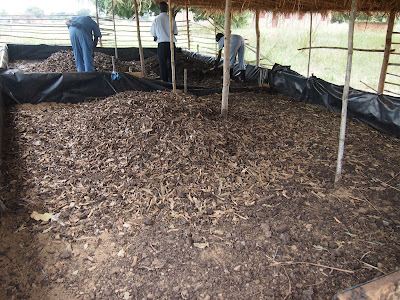Our UniWASH project is closely related to farming in the Northern Uganda. As a gap in our project is that we do not have an agricultural expert who is aware of the local soil and farming conditions. We are dealing with human manure that could be turned into fertiliser and sold to farmers. But we lack the information what is the real value of HWBF for the farmers? We rely on the assumptions that the human manure has fertile impact on the soil. Still as the manure is composted most of the nitrogen evaporates or is leached to the soil. Also the phosphorus has the tendency of absorbing to the soil particles and is as such quite rarely in soluble form for plants to use. So we are eagerly also waiting for the results from our fellow Makerere students on the nutrient content of the composted HWBF. Also the form of the nutrient (is it leachable or not) is an important fact.
During the field trip I was wondering the perception that the land is considered to be fertile even without added nutrients. I was wondering if that is really the case or just because some farmers don’t have money to buy chemical fertilisers. When one doesn't have money to certain commodity one might imagine they don't need it. Simple or complex, which one it is?
Also I was wondering the way we were told that the locals do not use fertilisers. To be honest, every time it sounded like I was being lobbied by a fertiliser company. Fertilising is much more than just applying chemical NPK (nitrogen-phosphorus-kalium) to the soil. It is also about farming skills. During the field trip I heard that the locals are quite aware of different fertilising techniques such as applying crop waste to the soils and the effect of traditional slash-burning. Also the use and effects of animal manure was well known. Local farmers were also quite aware of how the soil's pH conditions affect the growth and that liming and ash increases the pH. Crop rotation and land rotation were also applied. I also left wondering what are the locals' skills on biological nitrogen fixation as there was a lot of beans and such in crop rotation.
What ever the nutrient content of the HWBF is it can still act as a soil enrichment material. That is quite important especially if the land rotation is neglected and the land is losing it's fertility. As the soil has more organic material and carbon it might improve the plants nutrient uptake and improve the moisture conditions. This is quite significant in the Northern Uganda where the yield of the last growing season was seriously decreased due to the drought.
The real value of HWBF to the local farmers is quite a corner stone in our research. Emptying the latrines is quite amount of work and turning it into fertiliser takes a lot of time and effort. This is still something we really need to consider in the final concept we will eventually propose to UNICEF. How to disseminate the information of HWBF benefits in the community and make the preparation alluring and meaningful.
During the field trip I was wondering the perception that the land is considered to be fertile even without added nutrients. I was wondering if that is really the case or just because some farmers don’t have money to buy chemical fertilisers. When one doesn't have money to certain commodity one might imagine they don't need it. Simple or complex, which one it is?
Also I was wondering the way we were told that the locals do not use fertilisers. To be honest, every time it sounded like I was being lobbied by a fertiliser company. Fertilising is much more than just applying chemical NPK (nitrogen-phosphorus-kalium) to the soil. It is also about farming skills. During the field trip I heard that the locals are quite aware of different fertilising techniques such as applying crop waste to the soils and the effect of traditional slash-burning. Also the use and effects of animal manure was well known. Local farmers were also quite aware of how the soil's pH conditions affect the growth and that liming and ash increases the pH. Crop rotation and land rotation were also applied. I also left wondering what are the locals' skills on biological nitrogen fixation as there was a lot of beans and such in crop rotation.
What ever the nutrient content of the HWBF is it can still act as a soil enrichment material. That is quite important especially if the land rotation is neglected and the land is losing it's fertility. As the soil has more organic material and carbon it might improve the plants nutrient uptake and improve the moisture conditions. This is quite significant in the Northern Uganda where the yield of the last growing season was seriously decreased due to the drought.
The real value of HWBF to the local farmers is quite a corner stone in our research. Emptying the latrines is quite amount of work and turning it into fertiliser takes a lot of time and effort. This is still something we really need to consider in the final concept we will eventually propose to UNICEF. How to disseminate the information of HWBF benefits in the community and make the preparation alluring and meaningful.

Ei kommentteja:
Lähetä kommentti